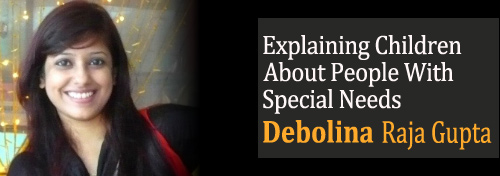Explaining Children About People With Special Needs
When the movie Barfi came out, both hubby and I were sure we wanted to watch it, and watch it with our daughter. The one thing we weren’t sure about was how to explain her the ‘differences’ shown in the movie that were sure to create some curiosities and questions in her.
If you’ve seen the movie, or in case you missed out on it (in which case you need to make a rush at the local DVD store and definitely watch it), the main characters in the movie are people with special needs – the lead male has special hearing and speech requirements, while the female lead has autism. And the main charm of the movie is that despite having different and special needs from those around them, these two characters create and live a life that is very special and very beautiful.
My daughter is 5, as I’m sure many of you know by now, and of course once she watched the movie, and even while she was watching it, there were a lot of questions running through her head. Her first concern and worry was why the male lead couldn’t speak or hear, now that he was a grown up too, and how would he hear what his papa was telling him!
One fact I loved about the movie was that there was no feeling of pity or trying to cover up the realities involving this way of life. And that is what I wanted to make my daughter understand. So, I made it a point to talk to her about the movie when I was back home, when I could pay more attention to her queries and tend to them better.
I explained to her that yes, there are many people and children out there who have a different way of life, that there are people who may have difficulties in certain areas, like not being able to see, not being able to speak, not being able to hear, but that does not mean they cry or feel sad about it. What that means to them is that they simply do those things in a different way. Like, if you can’t speak, you can try to write out what you want to say. Or, if you can’t hear, you can do a fun game of lip-reading, like the character does in the movie, and understand what the other person is trying to say.
My daughter has not encountered people with different needs in real life. There was an instance when she did meet a boy who had difficulties speaking, and she had met him for a little while. But as my daughter had already been explained about these aspects of life, she didn’t find anything different or out-of-place. Instead, they had quite a comfortable chat with each other using sign language, the dumb charade way and pointing way, and it turned out quite a fun and gameful conversation!
I know it can get quite hard to explain the entire concept to a young child, and the bigger concern here is that your child will form an impression of special-needs people based on what and how you talk to your child about it. So instead of trying to beat around the bush, it’s smarter to speak directly to your kids and tell them in a sensible way that connects both to their mind and their heart. Teach them to understand, not to pity.
Debolina Raja Gupta loves being a mommy and best friend to her 5-year old princess. A working mom, voracious reader, social activist, photographer, poet, travel freak, beauty writer and an everything-of-sorts. Best fun is story time and our fashionista time together. My blogs: The Book Worm, A Few Thoughts Here And There, My Little One And Me, Beauty Makeup And More.
